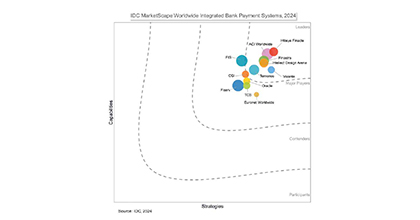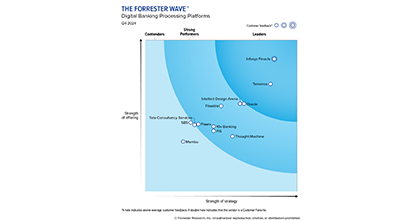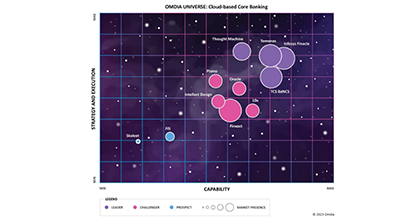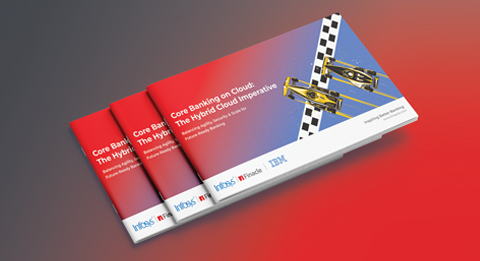-
![]() Quantum Computing: As the Future Awaits, The Strides Are DefinitiveQuantum computing is no longer confined to theory or the edges of experimental science - it is rapidly advancing toward practical impact.Read More
Quantum Computing: As the Future Awaits, The Strides Are DefinitiveQuantum computing is no longer confined to theory or the edges of experimental science - it is rapidly advancing toward practical impact.Read More -
![IDC IDC]() IDC MarketScape: Worldwide Integrated Bank PaymentFinacle Payments is an enterprise payments services system that manages end-to-end payments across instrument types, payment schemes, transaction types, customeRead More
IDC MarketScape: Worldwide Integrated Bank PaymentFinacle Payments is an enterprise payments services system that manages end-to-end payments across instrument types, payment schemes, transaction types, customeRead More -
![]() Supply Chain FinanceToday, as businesses seek to make their ecosystems more resilient, Supply Chain Finance (SCF) has emerged as a powerful lever for banks and financial institutions to support clients, while unlocking new revenue streams.Read More
Supply Chain FinanceToday, as businesses seek to make their ecosystems more resilient, Supply Chain Finance (SCF) has emerged as a powerful lever for banks and financial institutions to support clients, while unlocking new revenue streams.Read More
-
![]() The Future of Core Banking: Business and Technology EvolutionOur point of view paper, “The Future of Core Banking: Business and Technology Evolution”, serves as a candid and forward-looking benchmark of your institution’s readiness—and a strategic playbook for core modernization.Read More
The Future of Core Banking: Business and Technology EvolutionOur point of view paper, “The Future of Core Banking: Business and Technology Evolution”, serves as a candid and forward-looking benchmark of your institution’s readiness—and a strategic playbook for core modernization.Read More -
![The Forrester Wave The Forrester Wave]() Forrester Wave Digital Banking, Q4 2024Finacle is best suited for large retail, SMB, and corporate banks who seek a modern, comprehensive, innovative platform with superior support.Read More
Forrester Wave Digital Banking, Q4 2024Finacle is best suited for large retail, SMB, and corporate banks who seek a modern, comprehensive, innovative platform with superior support.Read More -
![]() Driving Comprehensive Revenue ManagementDiscover why revenue management must evolve into a comprehensive, strategic capability. Decode a blueprint to overcome challenges and unlock sustainable monetization.Read More
Driving Comprehensive Revenue ManagementDiscover why revenue management must evolve into a comprehensive, strategic capability. Decode a blueprint to overcome challenges and unlock sustainable monetization.Read More
-
![]() Shaping Banking’s Next: Banking Technology Trends for 2025 and BeyondThe banking industry has been balancing disruption and opportunity for several years now, and the pace of change shows no signs of slowing as we move into 2025 and beyond.Read More
Shaping Banking’s Next: Banking Technology Trends for 2025 and BeyondThe banking industry has been balancing disruption and opportunity for several years now, and the pace of change shows no signs of slowing as we move into 2025 and beyond.Read More -
![]() Virtual Accounts 2.0: Surpass Conventional Cash Management and Unlock Next-Gen PossibilitiesVirtual Account Management was a groundbreaking shift in the banking landscape, revolutionising use cases like cash concentration, pooling, centralised treasury management, and in-house banking (POBO, ROBO, COBO)Read More
Virtual Accounts 2.0: Surpass Conventional Cash Management and Unlock Next-Gen PossibilitiesVirtual Account Management was a groundbreaking shift in the banking landscape, revolutionising use cases like cash concentration, pooling, centralised treasury management, and in-house banking (POBO, ROBO, COBO)Read More -
![]() Unlocking Hybrid CloudAs banks push forward with their digital transformation agenda, cloud serves as a pivotal enabler. Each bank, at varying stages of adoption, crafts its unique path, dictated by context, regulations, and risk appetite.Read More
Unlocking Hybrid CloudAs banks push forward with their digital transformation agenda, cloud serves as a pivotal enabler. Each bank, at varying stages of adoption, crafts its unique path, dictated by context, regulations, and risk appetite.Read More
-
![]() Banking on CloudThis report from Infosys Finacle delves into the need for accelerating cloud adoption, highlights the current state of the industry, and puts forth key recommenRead More
Banking on CloudThis report from Infosys Finacle delves into the need for accelerating cloud adoption, highlights the current state of the industry, and puts forth key recommenRead More -
![]() Omdia Universe | Cloud-based Core BankingIn the report, Omdia highlights the following key capabilities of leading cloud-based core banking providers:Read more
Omdia Universe | Cloud-based Core BankingIn the report, Omdia highlights the following key capabilities of leading cloud-based core banking providers:Read more
-
![]() Emirates NBDEmirates NBD consolidates its operations on a single version for scalability, agility, and standardization.Read More
Emirates NBDEmirates NBD consolidates its operations on a single version for scalability, agility, and standardization.Read More -
![]() A Global Top 5 BankDiscover how a global top 5 bank headquartered in the US accelerated payments transformation.Read More
A Global Top 5 BankDiscover how a global top 5 bank headquartered in the US accelerated payments transformation.Read More -
![]() Union Bank of IndiaUnion Bank of India launches Union Virtual Connect (UVConn) by leveraging WhatsApp to provide customers personalized banking services.Read More
Union Bank of IndiaUnion Bank of India launches Union Virtual Connect (UVConn) by leveraging WhatsApp to provide customers personalized banking services.Read More

The Road to Leadership in Embedded Finance
Blogs
Over the past 20 years, banking transactions, half of which used to occur in-branch, have migrated predominantly to digital self-service channels. However, the bigger trend is that as we march further in this decade, many of these transactions will originate outside the bank network altogether. This is because, thanks to trends like open banking and banking as a service, bank transactions will be embedded within customers’ primary journeys for other products and services. In our view, this migration will be much faster than the first, because being more contextual and seamless, embedded finance experiences are likely to enjoy rapid adoption. As a proof point, look at India’s UPI-based open payment transactions, which are running at nearly 6 billion per month. Over 80 percent of these payments originate in two non-bank apps, PhonePe and Google Pay. This, despite there being more than 60 similar apps from incumbents, challengers and neobanks.
What’s more, embedded finance creates wins for all stakeholders: frictionless banking for customers; new business for merchants and brands who can attract customers with Buy Now Pay Later and other digital financing and payment options; and business expansion at affordable costs for banks, thanks to maturing digital infrastructures.
Thus, it’s not surprising that embedded finance is among the hottest opportunities in banking today, promising great returns to institutions that can embed their offerings across a variety of customer contexts. Also, it is not a zero-sum game by any means. There is enough room in the embedded finance ecosystem for all types of providers – incumbent, challenger, and neobanks – to coexist. This is particularly true for growing economies and underserved markets. For instance, household debt in India is less than 15 percent of GDP, compared to nearly 75 percent in the US and 55 percent in China.
That being said, banks looking to lead this opportunity should move quickly with their plans. The following three goals should be high on their agenda:
Scale Initiatives to Embed APIs Where Possible Throughout the Ecosystem
The starting point is to build a robust API infrastructure for exposing bank services and data to a variety of ecosystem partners. It is recommended to build APIs in standards-based formats, such as those published by BIAN, for widespread integration. An API management platform, assuring secure access to approved partners for approved purposes, is essential. Also, there needs to be a sandbox and accompanying documentation to ease the developer experience. A mature digital stack is imperative for supporting massive embedded finance transactions, at very high performance levels, and very low incidence of technical failure.
Progressive organisations are seen to approach API banking with a product management mindset, viewing APIs as a class of products for taking their services to third parties. Hence there is a dedicated product management team responsible for prioritising, developing, deploying, upgrading, and even retiring APIs; there are also teams to develop and test use cases with partners, especially for non-standard, industry-specific applications, and to support developers, partners and customers with their needs.
Embedded finance is a separate revenue stream that should be developed like any other line of business. Banks should therefore put together teams for promoting API banking and for building alliances with corporates, small businesses, large digital infrastructure providers, fintech firms, e-commerce players, and other entities. A key goal should be to evangelise APIs through the influential developer network.
Develop Unique Capabilities That Can Be Embedded Faster, Cheaper, Better
Stepping up digital transformation after the Covid-19 breakout, the majority of banks put basic APIs in place for their checking accounts, unsecured loans, payments, etc. As competition grows, APIs are commoditising further. Therefore, the question is how can one bank differentiate its API banking service from that of another.
Innovating with unique, or better, propositions is one way. Another is targeting specific niches, which may be product-based (for example, student loan APIs), segment-based (ICICI Bank has nearly 200 partners just for co-creating embedded experiences for SMEs), or service-based (for example, China’s PingAn One Connect for Identity Management as a Service ). Since many brands prefer to source embedded offerings from a one-stop-shop provider, it makes sense for banks to offer bundles that may even include others’ products, such as insurance with loans, virtual accounts with retail checking accounts and so on.
Take a Marketplace/ Ecosystem Approach to Expand the Business
When the above foundation is in place, the next step is to grow the business. A considered marketplace approach can help banks consolidate their lead in embedded finance. Apart from offering their own APIs/services, they can feature both complementary and competing third-party services to become a singular destination for banking APIs. From that position of power, they may be able to influence standards driving growth and information security in embedded finance, beyond the narrow regulatory prescriptions for open banking existing at present.
A marketplace expands a bank’s ecosystem on both the supply and demand side in a natural, self-sustaining way. When a marketplace features a number of brands, it becomes a magnet for supply-side partners, and vice-versa, thereby unlocking significant network benefits for its bank. As the ecosystem expands so does the data flowing through the marketplace platform, providing rich insights that the bank can use to enhance its embedded finance proposition.
Another benefit is the ability to dictate pricing. When a bank offers many API-based services, it can price the basic (undifferentiated) capabilities very competitively to lower the entry barrier and charge a premium on unique or high-value services. Last and by no means least, a marketplace is the go-to destination of large embedders who prefer to fulfil all their requirements in one place.
For all these reasons, it is believed that the quality of a bank’s financial health will be determined by the strength of its ecosystem/marketplace.
What could be a better argument in favour of embedded finance?
This article was previously published in The Banker.



©2025 -Edgeverve Systems Limited | All rights reserved


















